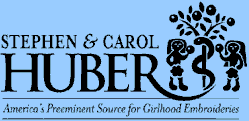|
Exhibition:With Needle & Brush
Schoolgirl Embroidery from the Connecticut River Valley
Guest curators:
Carol & Stephen Huber
(pictures with discriptions are all at the bottom of this article)
Between 1650 and 1850, the Connecticut River Valley was one of the most important areas in America for the teaching
and production of embroidery works by young school girls. Tutored in various academies, these precocious needleworkers
created pictures and other images that have become widely recognized for their importance in American history in
recent years.
Often beginning before the age of 10 with elementary samplers worked on linen, Connecticut Valley girls developed
a variety of increasingly sophisticated stitching techniques. Executing their samplers, canvas work pieces, memorials
and silk pictures, they signaled their suitability to be wives capable of managing a household and educating offspring.
Embroidered pictures and memorials, often displayed in a family's home, reflected their makers' mastery of the
principles of "politeness"- a concept suggesting knowledge of religious and literary subjects, as well
as an appreciation for art and music.
Guest-curated by pioneering needlework dealers Carol and Stephen Huber, "With Needle and Brush: Schoolgirl
Embroidery From the Connecticut River Valley" is a welcome and revelatory exhibition. On view at historic
Florence Griswold Museum through January 30, this is the first time samplers, canvas work and embroideries produced
by Connecticut Valley girls have been examined as a group.
"Schoolgirl Embroidery" offers insights into the traditions of needlework, the evolution of embroidering
techniques, the impact of school mistresses who nurtured distinctive works of enduring appeal and the nature of
young women's schooling before the advent of widespread public education. Comprising some 75 samplers and other
embroideries, watercolor pictures and portraits, the show draws heavily on examples from private collections, many
never before seen publicly. A companion book will be published next year.
As the exhibition unfolds, visitors will see how young girls started with simple stitching projects involving alphabets
and numbers before progressing to more advanced needlework as their skills improved. Teachers in the area's urban
centers, with ties to Boston or Providence, were exposed to current styles that they passed on to their pupils.
Schoolgirls in rural Connecticut Valley towns had instructors untutored in contemporary trends who relied instead
on their own vernacular creative designs or British precedents.
"Consequently," observe the Hubers, "work from the valley is diverse, ranging from folksy, simple
samplers to sophisticated embroidery and watercolors copied from prints, to elaborate coats of arms embellished
with silver metallic thread." Moreover, they add, valley needlework is different from that of other areas
in New England because of the continuity of families in the area, which "allowed distinct regional characteristics
to develop." This multigenerational permanence "resulted in a more ingrown culture with strong local
roots."
The results, wonderful to behold, represent astonishing creations by unsophisticated and quite young needleworkers.
A highlight of the exhibition is a colorful, lively canvas work garden scene outside a substantial brick house
featuring courting couples, servants serving refreshments, children playing and a cupid flying overhead aiming
its bow. Originating in the Chandler family of Pomfret, Conn., it is said to have been stitched by a daughter of
John Chandler Jr and Hannah Gardiner in 1758. Reminiscent of British "conversation pieces," this sophisticated
work continues to appeal to Twenty-First Century viewers.
Equally charming is a vividly colored work executed in 1762 by 17- year-old Alethea Stiles of Woodstock, Conn.
It is based on popular Eighteenth Century French prints of a reclining shepherdess and a nearby shepherd attending
his sheep. In addition to the two major figures, the foreground is festooned with animals, flowers, trees and grass,
with a substantial manor house looming in the distance. Alas, Stiles's accomplished, vibrant composition did not
presage happiness; she married briefly and unfortunately died at the age of 38.
Some of the most graphic, color-filled and fanciful Connecticut Valley embroidery creations emerged in the form
of canvas works around the middle of the Eighteenth Century. While some images derived from established designs,
many were original and innovative. Some of these needlework pictures featured identifiable buildings, animals and
people; others were more whimsical and adventurous. The star in the exhibition is a circa 1745, brilliantly hued
floral wool on linen, measuring13 by 16 inches, by Mary Lockwood, likely of Fairfield County, Conn.
As might be expected, some of the oldest schoolgirl work in the exhibition, dating to the Seventeenth Century,
draws heavily on samplers stitched in Mother England. As they mastered basic skills, Connecticut Valley girls later
on demonstrated their expertise in tent stitching -needlepoint today - in the form of needlework pictures that
continued to recall British precedents.
As the Hubers observe, "The education of all began with the making of a sampler" - i.e., images stitched
with silk thread on linen backgrounds by neophytes in the form of alphabets, numbers and other routine markings,
with
perhaps some decorative touches. As students became more proficient, these so-called "marking samplers"
were replaced by more complex works that were sometimes so well done that they were framed and proudly displayed.
Like other areas of the country, Connecticut Valley samplers featured distinctive techniques, styles and subjects.
An early sampler by 12-year-old Alice Mather of Lyme, Conn., a 1774 pastoral scene replete with reclining shepherdess,
palm tree and a blue house set against a solidly stitched black background, is set off by a floral chintz border.
Another notable sampler on view is one dating to the1780s by Elizabeth Moore Huntington, who studied under an unknown
schoolmistress in Norwich, Conn. Daughter of General Jedediah Huntington, this 8-yearoldneedleworking whiz produced
a highly ambitious piece featuring a variety of stitches and designs, alphabets and numbers and three verses of
Joseph Addison's hymn, "When all thy mercies, O my God" of 1712. The surround of flowers and strawberries
complete an amazingly accomplished work.
Another ambitious piece, created by 15-year-old Polly Jennings of Norwich, blends silk, sequins, gold foil and
paint on black silk in a charming courting scene. Depicted in a landscape setting are a shepherd and shepherdess,
plus cows, sheep, dog and a house with smoke rising from the chimney. Such "garden and pastoral scenes were
romantic indulgences," say the Hubers.
One of the most ambitious sampler compositions on view was fashioned in 1804, probably in Northampton, Mass., by
9-year-old Wealthy Griswold of Windsor, Conn. Throwing in everything but the kitchen sink, this young lady herded
within a roughly 16-by-16-inch format analphabet, numbers, flowers, baskets, birds, trees and a shepherdess in
a central oval guarding sheep. A crowned lion mimics an Eighteenth Century English sampler motif. The bottom inscription
reads: "Then O divine benevolence be night / & teach me how to live and how to die."
Family record samplers, widely popular in the early nineteenth century, documented births, deaths and marriages.
While attending Miss Cornwall's school in Hebron, 14-year-old Mary Ann Post executed an imposing composition that
chronicles the saga of her family.
Of particular interest to many will be examples of memorials, silk embroidered mourning pictures that represented
expected accomplishments of cultured young ladies of the time. These sensitive and poignant memorials typically
display a gravestone, languid willow trees and weeping figures. "Contrary to popular belief," say the
Hubers, "the stitchers of these memorials were not necessarily in mourning over the loss of a loved one, but
merely creating a popular form of needlework."
One fascinating piece by teenaged Maria Hulbert was produced at Abby Wright's South Hadley, Mass., school, known
for its imaginative, heavily embellished memorials trimmed with silver metallic thread. Stitched around 1805, Hulbert's
"Memorial to the Hulbert Family" shows identical figures, likely representing the artist and her sister,
hovering over their parents' gravestones, with intricately rendered weeping willow trees presiding behind them.
Less common, because they were more difficult to create, were watercolor memorials on silk. Vermont native Lucy
Hubbard Chillson, aged 11 in 1806, painted a memorial to her father, surrounding the work with gold paper. Measuring
157/8 by 193/8 inches, it features a winged angel carrying a memorial banner.
Due to the stress on refinement among wealthy New Englanders, young ladies in population centers like Boston and
Providence often attended more than one "finishing school." "Education for a young woman in the
late Eighteenth and early Nineteenth Centuries could easily exceed the cost of sending a young man to Harvard or
Yale," the Hubers point out. Three important academies that taught embroidered needlework were established
in Connecticut during this period, by Miss Sarah Patten in Hartford (1785), Miss Sarah Pierce in Litchfield (1792)
and Mrs. Lydia Bull Royse in Hartford (circa1800).
The Patten school encouraged students to develop compositions with floral garlands and padded eagles surrounding
colorful pictorial scenes based on allegorical or biblical subjects. Eighteen-year-old student Louisa Bellows of
Walpole, NH,, chose the fashionable subject of Charity for her silk embroidery of around 1810. This good-sized
(18¾ by 25¼ inches) work is notable for the detailed watercolor townscape in the background.
Designed for display in the homes of daughters of prominent people, family coats of arms were important products
of Miss Patten's school in Hartford in the early Nineteenth Century. The large padded eagle holding a floral garland,
ears of wheat or fronds and an inscription ribbon identify the anonymously executed "Williams Coat of Arms"
as a symbol of status and wealth.
Among the works on view painted at the Pierce school is an elaborate watercolor on silk memorial to the Butler
family. Created by an unknown maker, it depicts family members who were likely involved in international trade.
Eunice Noyes, aged 16, of Lyme, Conn., painted part of a classical historic vignette, "Blanch & Henriques,"
probably drawn from a print, while studying at Lydia Rouse's school in Hartford. The faces, painted by the schoolmistress
herself, suggest that this is a depiction of the marriage proposal of King Henry IV to Blanch II of Navarre.
Samplers and other simpler items were staples of public schools, whereas silk pictures were the province of private
schools and academies. "Silk embroideries were the apogee of a girl's education," say the Hubers, pointing
out that silk pieces often required six to 12 months to complete, at which point they were taken home for exhibition
in the family's "best" parlor.
The appealing images and skillful handwork that went into the pieces in this exhibition continue to impress and
attract current viewers. The exhibition proves, moreover, that Connecticut Valley schoolgirl needlework belongs
among the ranks of fine art, suitable for major museum showings. The exhibition will be followed by a fully illustrated
book with essays and entries by the Hubers and other experts, to be published by Wesleyan University Press in 2011.
The Florence Griswold Museum is at 96 Lyme Street. For information, 860-434-5542, extension 111, or www.flogris.org.
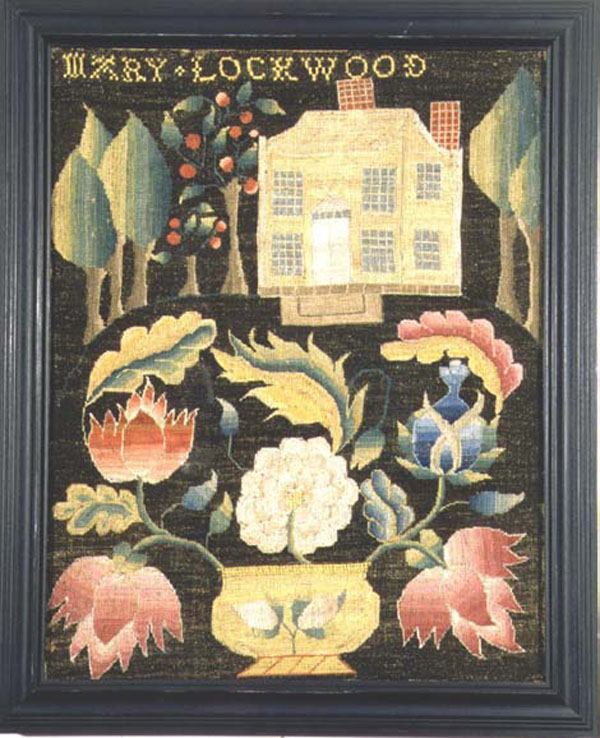
Even within the small group of similar mid-Eighteenth Century needlework pictures, Mary Lockwood's design sense
is notable. There were several Mary Lockwoods born in Fairfield County, Conn., in the early to mid-1730s. Wool
on linen.
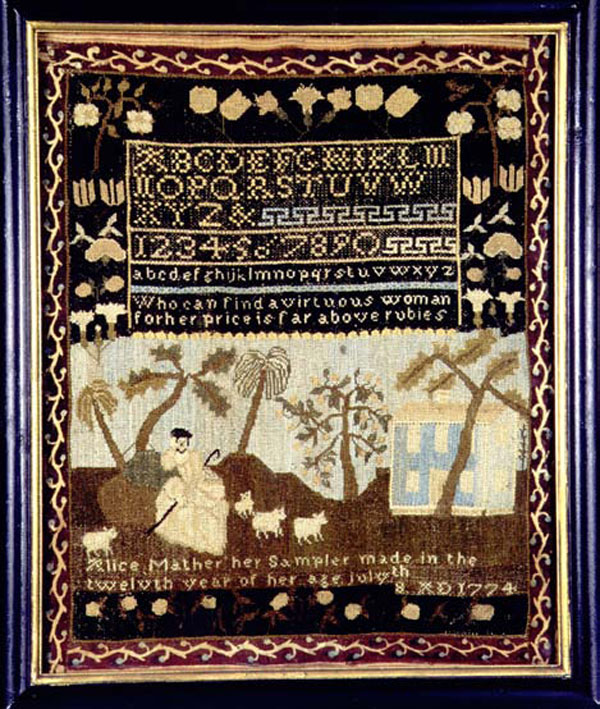
Dramatic with its overall stitching, this sampler by Alice Mather included a bucolic scenic panel. She further
enhanced it with the unusual addition of a floral chintz applied border. The solidly stitched black background
appeared in Norwich in the 1760s, as did small sections of a Greek key pattern. The blue house depicted is found
on earlier Norwich canvaswork and the same Biblical verse (Proverbs31:10) is found on a sampler worked by Naby
Lord of Norwich in 1765. The reclining shepherdess figure was popular on canvaswork pieces in Boston in the mid-Eighteenth
Century and the palm tree became a signature characteristic on later work stitched at the Misses Pattens' school
in Hartford. Silk on linen with a printed chintz border.
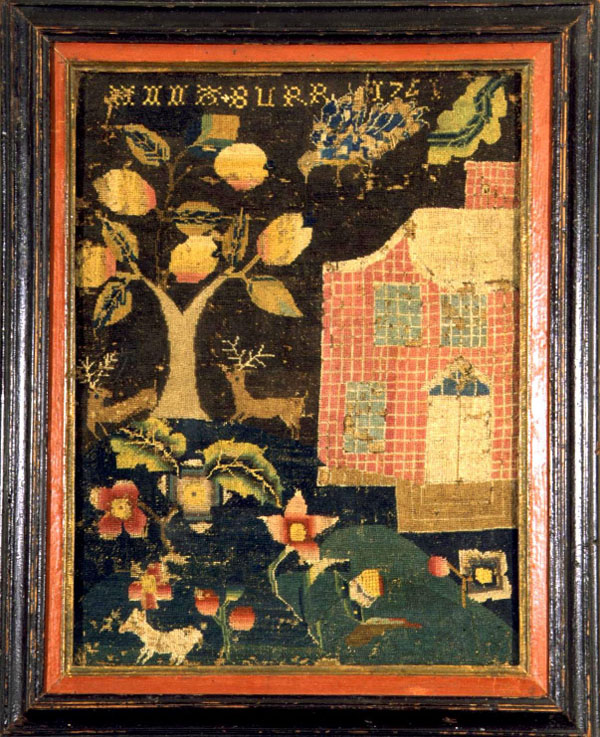
This wonderfully folksy 1741 example by Anna Burr is the only one of the group that is dated. Anna's was the
key to understanding the others that were thought to be much later. By assigning an analogous date to the pair
of needlework pictures worked by Mary Lockwood, it was discovered that Anna Burr and Mary Lockwood were distantly
related contemporaries from the same area, enhancing the Fairfield, Conn., connection. Wool on linen.
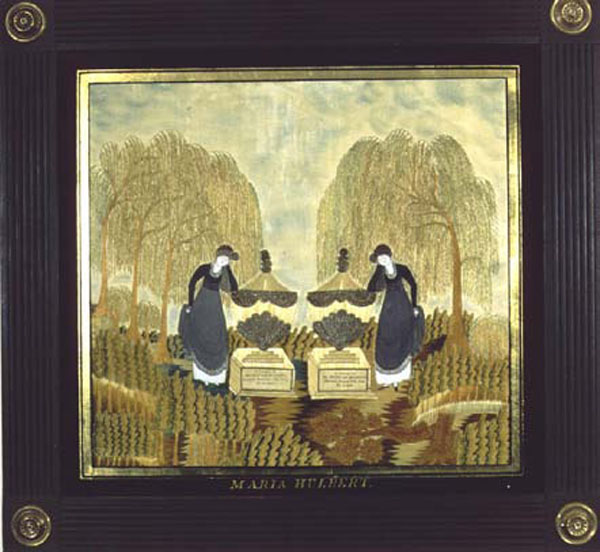
A native of Middletown, Conn., Maria Hulbert was about 15 years old when she produced this fine silk embroidered
memorial at the Abby Wright School in South Hadley, Mass., around 1803. The mourning picture memorializing her
parents includes two figures likely representing herself and her sister standing in front of the inevitable weeping
willows.
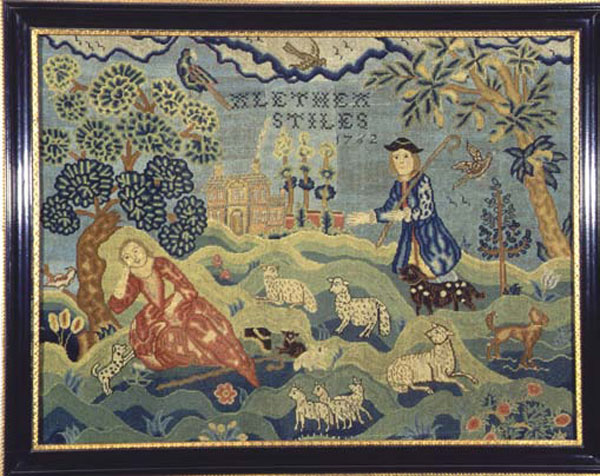
Playing off popular Seventeenth Century French prints of a "Reclining Shepherdess" with a shepherd
nearby watching his sheep, this canvas work by Alethea Stiles, 1762, demonstrates skillful use of wool and silk
on linen. Daughter of a minister in a distinguished family in Woodstock, Conn., Althea executed this vivid picture
when she was 17 and attending a Boston school.

This elaborate and impressive "Family Register Sampler," 1827, was made by Mary Ann Post at Miss Cornwall's
School in Glastonbury, Conn. The 14-year-old recorded significant dates in the family history in an interesting
composition.
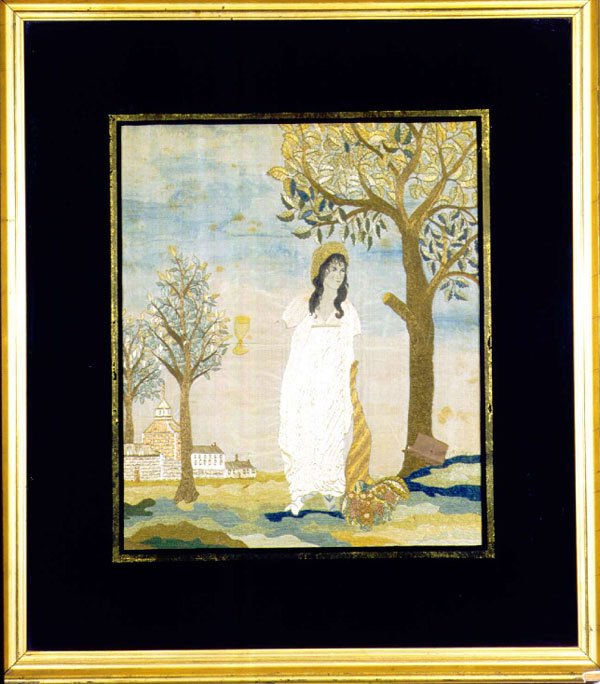
The unknown maker did not complete her rendition of "Plenty," which was most likely was adapted from
an Edward Savage engraving of1796 titled "Liberty Giving Sustenance to the Bald Eagle." Patriotic themes
were widely copied in the early Nineteenth Century. She is flanked by trees with a grouping of buildings in the
lower left background, which are found on other Connecticut silk embroideries. This and two other almost identical
embroideries have a history of being from Old Saybrook, Conn., circa 1815. Silk and watercolor on silk.
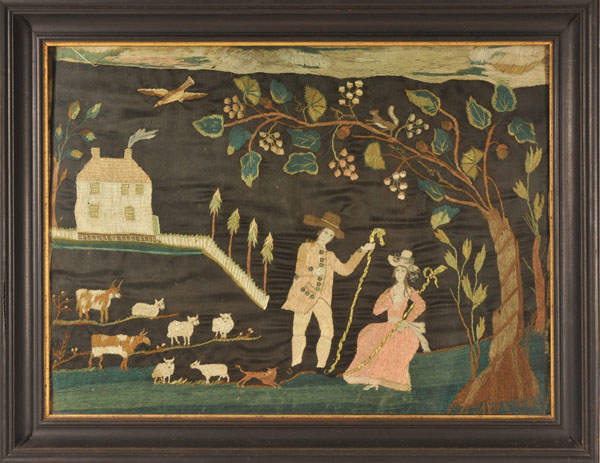
Polly Jennings created a delightful courting scene with shepherd and shepherdess in a landscape complete with
sheep, cows and dog with a house spewing smoke from the chimney and a tree laden with grapes. Garden and pastoral
scenes were romantic indulgences and often created in paint or needlework. Born in 1778, Polly Jennings was the
daughter of Zephaniah Jennings and Phebe Trap of Norwich, Conn. Silk, paint, sequins and gold foil on black silk.
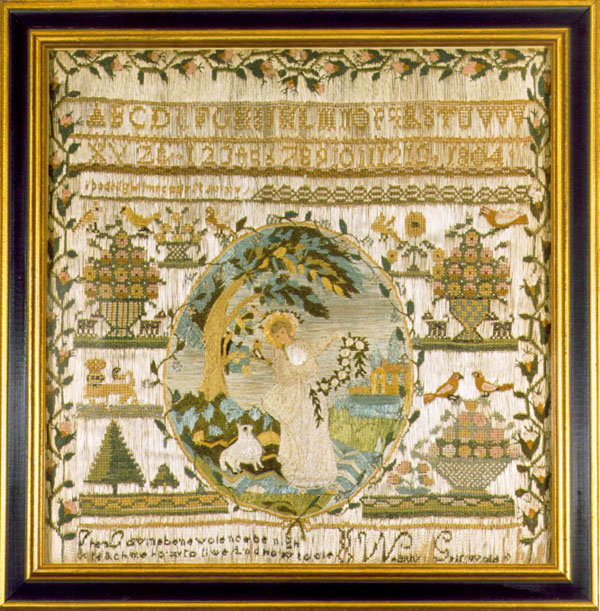
This delightful composition was worked by Wealthy Griswold in 1804. The alphabet, numbers, flowers, baskets,
birds and trees are worked in crossstitch and the background completely filled in. The center vine-bordered oval
depicts a playful shepherdess with garland looking over her sheep, while birds rest in a nearby tree and a house
in the background fill out the landscape. The asymmetrical design of the elements surrounding the oval portion
includes a crowned lion, a motif found on English samplers from the Eighteenth Century. The sampler features an
unusual combination of oval picture and sampler surround with a difficult long-stitch filled background. It demonstrates
Wealthy's skill with the needle. To date, only a few have been found from this group and evidence suggests they
were made in the Northampton, Mass., area in the early Nineteenth Century. Silk, paper and ink on linen. At the
age of 16, Eunice Noyes stitched this colorful silk, drawn from a print of a historical scene, "Blanch,"
circa 1807. It was made at Lydia Royce School, with the faces painted by the school mistress.
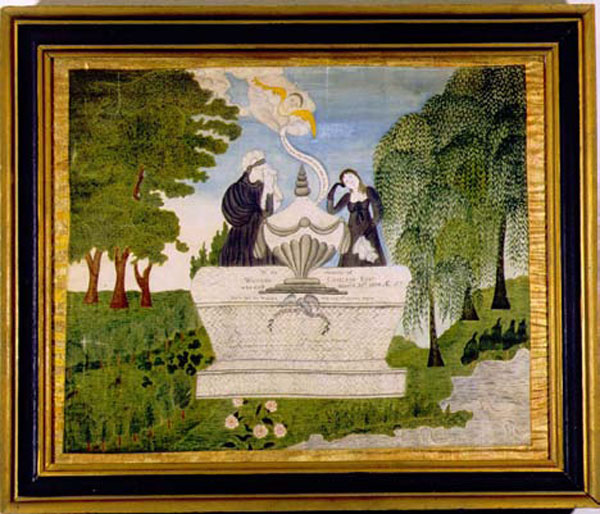
Watercolor memorials on silk were more difficult to execute and are not as plentiful those painted on paper
or worked as silk embroideries..Lucy Chillson used short brush strokes to imitate embroidery stitches in her memorial
to her father and surrounded her work with gold paper. The winged angel carrying an inscribed banner appears repeatedly
in watercolors and embroideries from Great Barrington, Mass., under the tutelage of a teacher from Wethersfield,
Conn., suggesting the teacher or one of her students may have traveled to Weathersfield, Vt., where this was painted.
Watercolor on silk with gold band of paper surround, 157/8by 193/8 inches.
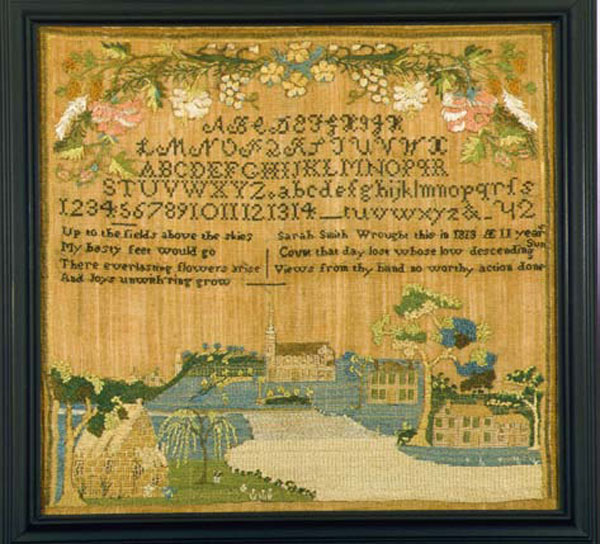
Scenic samplers depicting identifiable houses and buildings, such as this example of 1824 by Sarah Smith of Wethersfield,
Conn., were popular in the Connecticut River Valley. The river stitched in the foreground leads the eye to the
central building, the First Congregational Church in the artist's home town.
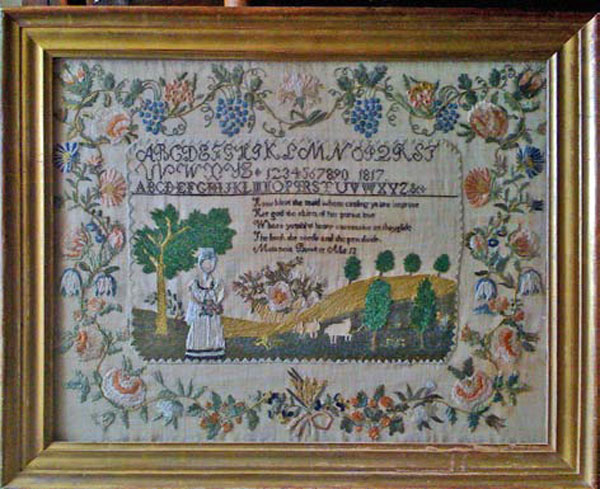
A paper-faced girl holding a bouquet stands in a disproportionate landscape with paper sheep and a lavishly
embroidered floral border on this large sampler stitched by Melancia Bowker in1817. One of a small group of samplers
from the area, they are easily identified by the central landscape scene of girl with nosegay next to a large basket
of flowers outlined with a sawtooth border. Silk, chenille and paper on linen.
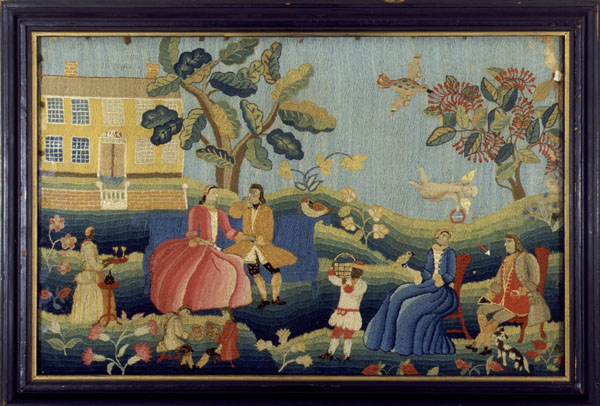
This crowd-pleasing, color-filled "Canvas-work with Chandler Home," 1758, was apparently made by a
daughter of John Chandler Jr. of Worcester, Mass., and Woodstock, Conn. Two courting couples, waited on by servants
with food and drink, are arrayed in front of the Chandler home as the man at the right is about to be smitten by
cupid's arrow.
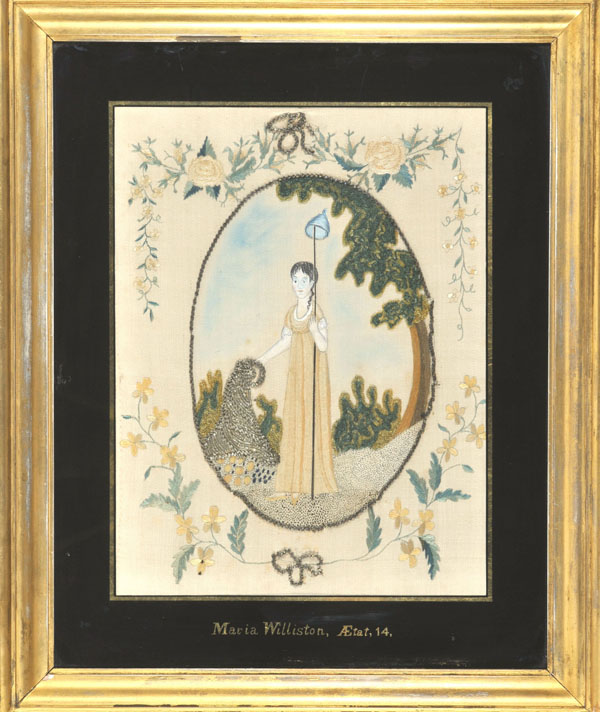
Wearing the latest empire fashion, Liberty, holding a staff topped with a liberty cap and an inverted cornucopia
spilling fruit, was stitched and painted by Maria Williston. The abundant use of silver threads and the distinctive
curvy trees are classic characteristics of needlework from Abby Wright's school in South Hadley, Mass. The swagged
floral vines with centered bows are prevalent in works from both her school and the Misses Pattens' school in Hartford,
Conn. Silk, metallic thread, chenille and watercolor on silk.
|

